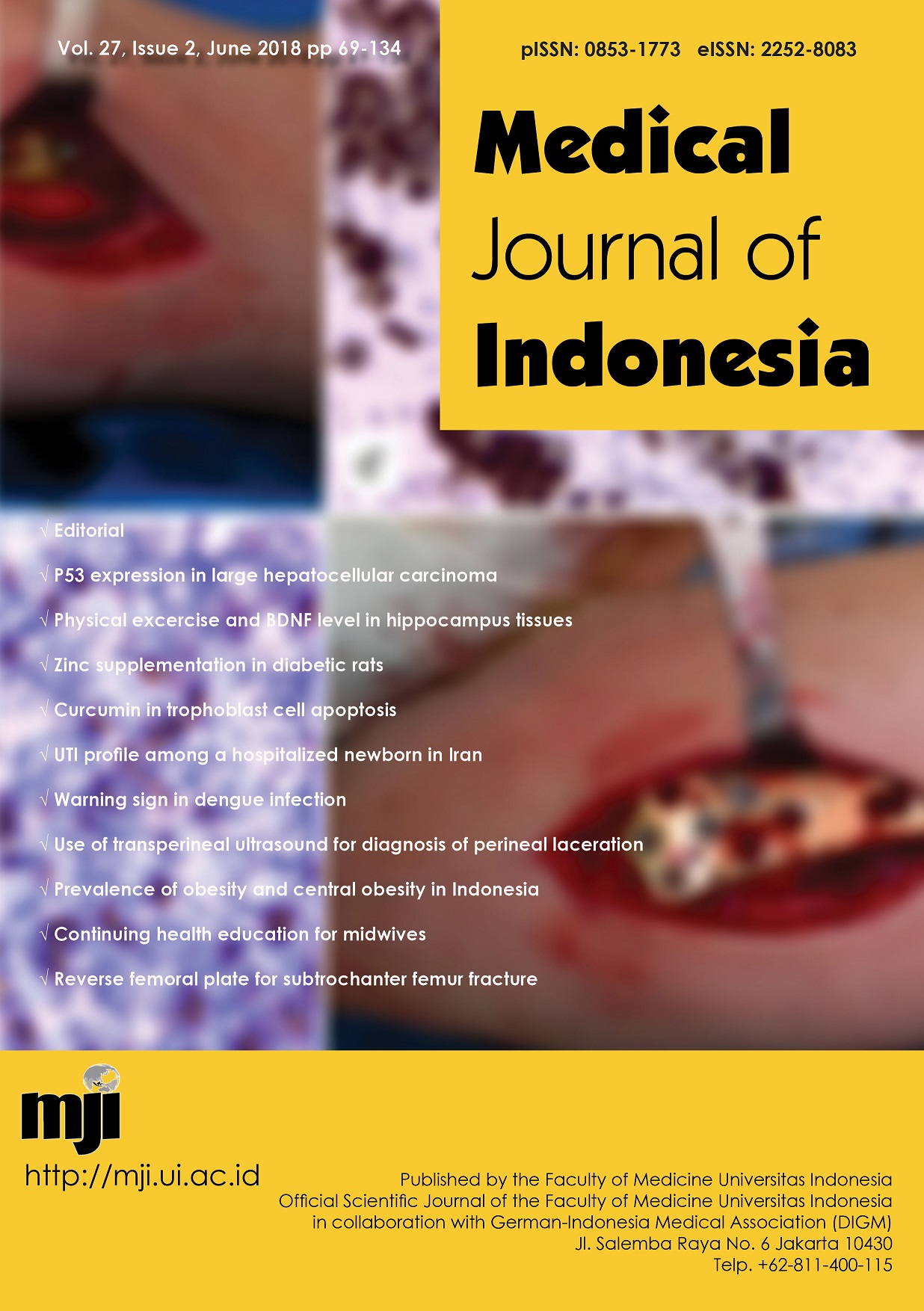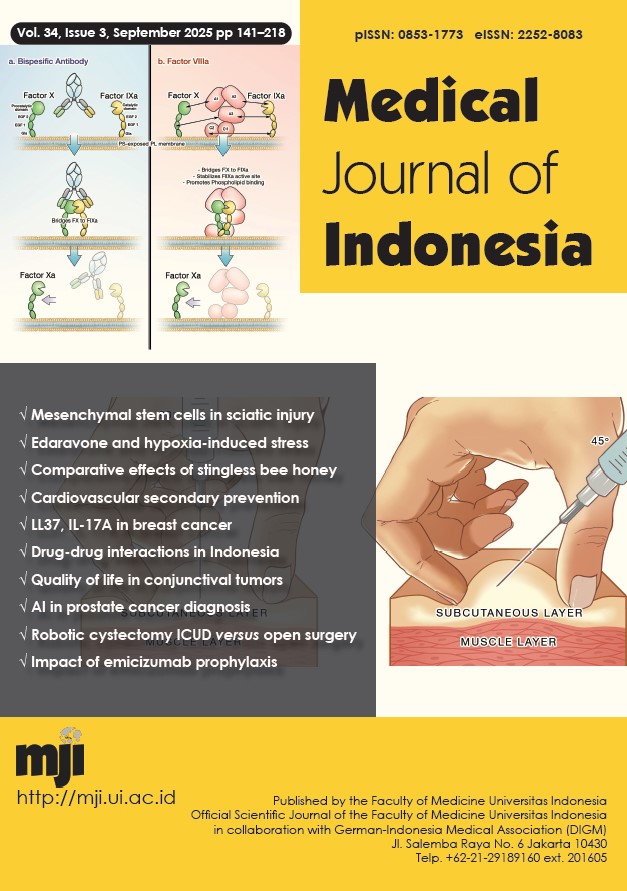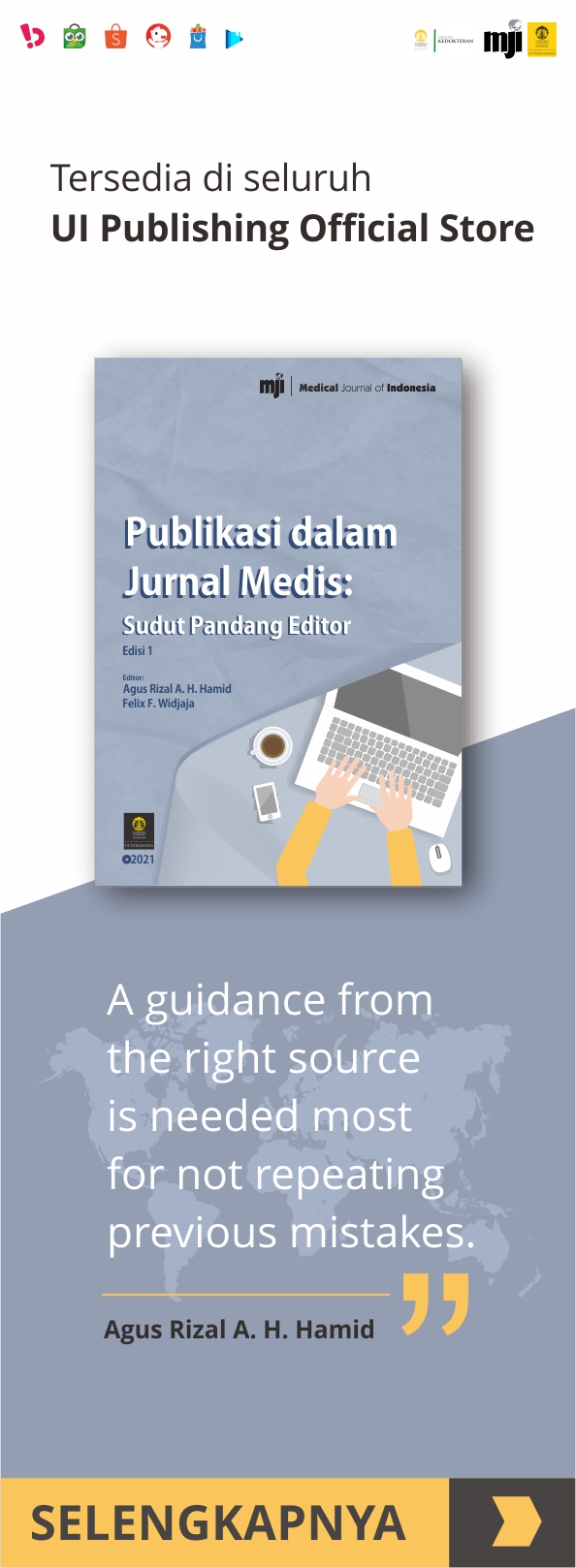Use of 2D and multislice transperineal ultrasonography to describe the degree of perineal laceration following vaginal delivery
DOI:
https://doi.org/10.13181/mji.v27i2.1908Keywords:
2D or multislice transperineal ultrasonography, perineal laceration, pill-rolling test, vaginal deliveryAbstract
Background: Perineal tear is the most common complication after vaginal delivery. Pill-rolling test is a widely used clinical evaluation method to determine the degree of perineal tear. However, the evaluation results of anal sphincter complex (ASC) differ between clinical examination and 2D/multislice transperineal ultrasonography (TPUS). This study aims to describe measurement variation between these modalities.
Methods: This cross-sectional study was conducted at Cipto Mangunkusumo Hospital from November 2015 to May 2016. Subjects were primiparous women after vaginal delivery. Clinical examination using pill-rolling test was performed to determine the degree of perineal laceration. Suture was conducted accordingly. The subjects were subjected to 2D/multislice TPUS 72 hours after delivery to evaluate the integrity of internal and external anal sphincters. Data were collected and analyzed to determine compatibility between these examinations.
Results: Among 70 prospective primiparous women, five were excluded due to unavailability to undergo 2D/multislice TPUS 72 hours after delivery. The mean duration to perform 2D/multislice TPUS was 4.5 minutes, and pain was tolerable during the examination. The compatibility values of clinical examination with 2D and multislice TPUS were 0.98 and 0.93, respectively, with Cohenâs kappa of 0.92 (95% CI 0.81-1.00) and 0.79 (95% CI 0.58-0.99), respectively.
Conclusion: Clinical examination is compatible with 2D/multislice TPUS for determining the degree of perineal tear after vaginal delivery.
Downloads
References
Meriwether KV, Hall RJ, Leeman LM, Migliaccio L, Qualls C, Rogers RG. Anal sphincter complex: 2D and 3D endoanal and translabial ultrasound measurement variation in normal postpartum measurements. Int Urogynecol J. 2015;26(4):511-7. https://doi.org/10.1007/s00192-014-2524-5
Meriwether KV, Hall RJ, Leeman LM, Migliaccio L, Qualls C, Rogers RG. Postpartum translabial 2D and 3D ultrasound measurements of the anal sphincter complex in primiparous women delivering by vaginal birth versus cesarean delivery. Int Urogynecol J. 2014;25(3):329-36. https://doi.org/10.1007/s00192-013-2215-7
Rieger N, Schloithe A, Saccone G, Wattchow D. A prospective study of anal sphincter injury due to childbirth. Scand J Gastroenterol. 1998;33(9):950-5. https://doi.org/10.1080/003655298750026976
McCandlish R, Bowler U, van Asten H, Berridge G, Winter C, Sames L, et al. A randomised controlled trial of care of the perineum during second stage of normal labour. Br J Obstet Gynaecol. 1998;105(12):1262-72. https://doi.org/10.1111/j.1471-0528.1998.tb10004.x
Christianson LM, Bovbjerg VE, McDavitt EC, Hullfish KL. Risk factors for perineal injury during delivery. Am J Obstet Gynecol. 2003;189(1):255-60. https://doi.org/10.1067/mob.2003.547
Roos AM, Abdool Z, Sultan AH, Thakar R. The diagnostic accuracy of endovaginal and transperineal ultrasound for detecting anal sphincter defects: the PREDICT study. Clin Radiol. 2011; 66(7):597-604. https://doi.org/10.1016/j.crad.2010.11.017
Abdool Z, Sultan AH, Thakar R. Ultrasound imaging of the anal sphincter complex: a review. Br J Radiol. 2012; 85(1015):865-75. https://doi.org/10.1259/bjr/27314678
Sultan AH, Kamm MA, Hudson CN, Thomas JM, Bartram CI. Anal-sphincter disruption during vaginal delivery. N Engl J Med. 1993;329(26):1905-11. https://doi.org/10.1056/NEJM199312233292601
Valsky DV, Messing B, Petkova R, Savchev S, Rosenak D, Hochner-Celnikier D, et al. Postpartum evaluation of the anal sphincter by transperineal three-dimensional ultrasound in primiparous women after vaginal delivery and following surgical repair of third-degree tears by the overlapping technique. Ultrasound Obstet Gynecol. 2007;29(2):195â??204. https://doi.org/10.1002/uog.3923
Fernando RJ, Sultan AH, Kettle C, Thakar R. Methods of repair for obstetric anal sphincter injury. Cochrane Database Syst Rev. 2013;8(12):CD002866. https://doi.org/10.100 /14651858.CD002866.pub3
Dickinson KJ, Pickersgill P, Anwar S. Functional and physiological outcomes following repair of obstetrics anal sphincter injury. A case. Int J Surg. 2013;11(10):1137-40. https://doi.org/10.1016/j.ijsu.2013.08.017
van Roon Y, Kirwin C, Rahman N, Vinayakarao L, Melson L, Kester N, et al. Comparison of obstetric anal sphincter injuries in nulliparous women before and after EPISCISSORS-60® at two hospitals in the United Kingdom. Int J Womens Health. 2015;7:949–55. https://doi.org/10.2147/IJWH.S94680
Sultan AH, Ranee T, Fenner DE. Diagnosis of perineal trauma. In: Perineal and Anal Sphincter Trauma: Diagnosis and Clinical Management. London: Springer-Verlag; 2007. p. 13-9. https://doi.org/10.1007/978-1-84628-503-5_2
Thiruvoth FM, Mohapatra DP, Sivakumar DK, Chittoria RK, Nandhagopal V. Current concepts in the physiology of adult wound healing. Plast Aesthet Res. 2015;2(5):250-6. https://doi.org/10.4103/2347-9264.158851
Shek KL, Guzman-Rojas R, Dietz HP. Residual defects of the external anal sphincter following primary repair: an observational study using transperineal ultrasound. Ultrasound Obstet Gynecol. 2014;44(6):704-9. https://doi.org/10.1002/uog.13368
Dietz HP. Pelvic floor ultrasound: a review. Am J Obstet Gynecol. 2010;202(4):321-34. https://doi.org/10.1016/j.ajog.2009.08.018
Weinstein MM, Pretorius DH, Jung SA, Nager CW, Mittal RK. Transperineal three-dimensional ultrasound imaging for detection of anatomic defects in the anal sphincter complex muscles. Clin Gastroenterol Hepatol. 2009;7(2):205-11. https://doi.org/10.1016/j.cgh.2008.08.019
Wieczorek AP, Stankiewicz A, Santoro GA, Woźniak MM, Bogusiewicz M, Rechberger T. Pelvic floor disorders: role of new ultrasonographic techniques. World J Urol. 2011;29(5):615-23. https://doi.org/10.1007/s00345-011-0708-x
Published
How to Cite
Issue
Section
License
Authors who publish with Medical Journal of Indonesia agree to the following terms:
- Authors retain copyright and grant Medical Journal of Indonesia right of first publication with the work simultaneously licensed under a Creative Commons Attribution-NonCommercial License that allows others to remix, adapt, build upon the work non-commercially with an acknowledgment of the work’s authorship and initial publication in Medical Journal of Indonesia.
- Authors are permitted to copy and redistribute the journal's published version of the work non-commercially (e.g., post it to an institutional repository or publish it in a book), with an acknowledgment of its initial publication in Medical Journal of Indonesia.






































